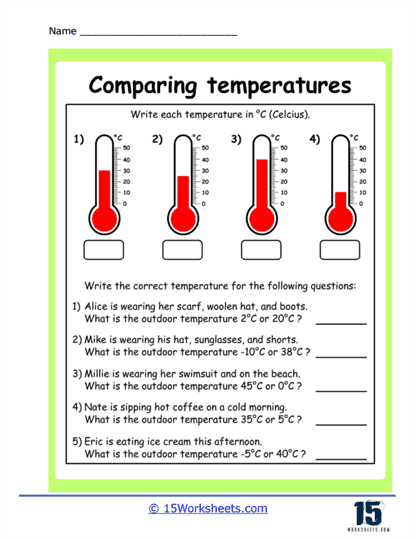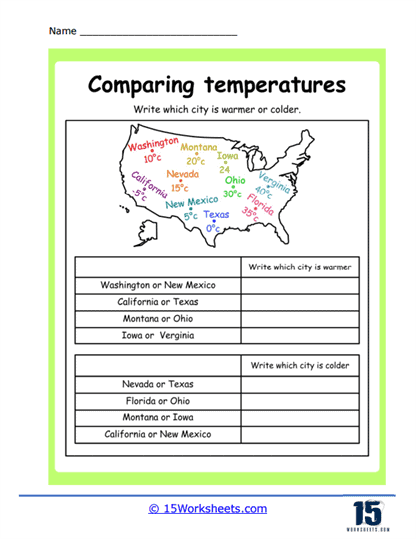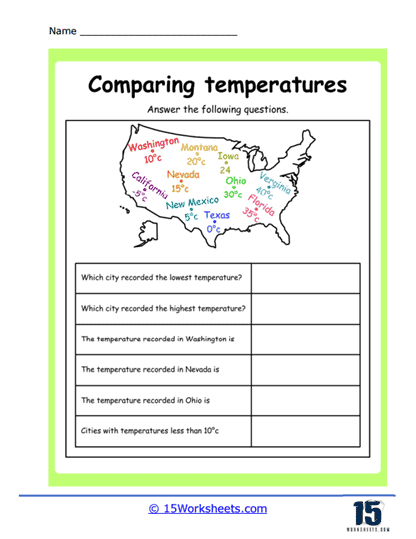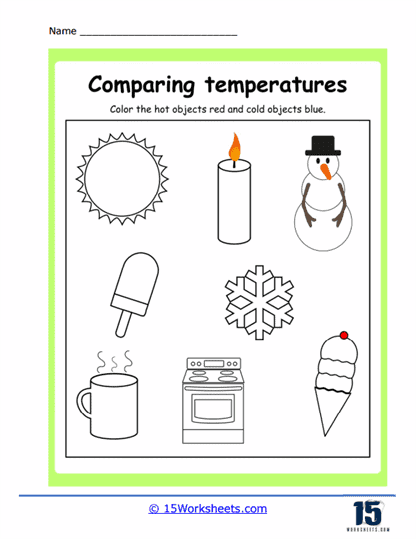Comparing Temperatures Worksheets
About These 15 Worksheets
When we talk about the climate, the weather, or even our body’s state of health, temperature plays a pivotal role. The ability to understand and compare temperatures is an essential life skill. Understanding when something is too hot or too cold can help us stay away from danger.
These worksheets were created to teach you teach students the fundamental concepts surrounding temperature. They focus not only on reading temperature values from tools like thermometers but also on comparing these values to determine which is higher, lower, or whether two values are the same. Such sheets often integrate various temperature scales like Celsius, Fahrenheit, and occasionally Kelvin.
By using these worksheets, students will become equipped with a foundational understanding of how temperature works, its relevance in the world around them, and the ability to make informed decisions based on temperature data.
Types of Exercises on These Worksheets
Reading Thermometers – These are exercises where students are provided images of thermometers with different scales, and they are tasked with reading the temperature shown. This foundational exercise familiarizes students with thermometers as tools and teaches them how to read temperature values accurately.
Higher or Lower – Here, students might be presented with two thermometer readings and asked to determine which one shows a higher or lower temperature. This type of exercise reinforces the concept of comparison at a basic level, ensuring that students can differentiate between higher and lower temperature readings.
Matching – Students are given a list of temperatures and a set of thermometer illustrations. They must match the temperature value to the correct thermometer. This exercise tests the student’s ability to read and associate abstract numerical values with visual representations.
Converting Between Scales – Given a temperature in one scale (e.g., Celsius), students are asked to convert it to another scale (e.g., Fahrenheit) using the appropriate formula. This exercise emphasizes flexibility in understanding temperature and ensures students can operate in environments where multiple scales are in use.
Intervals – Students might be tasked with determining the difference in temperature between two readings or finding a median temperature between two values. This helps students develop the ability to work with temperature as a quantitative value, paving the way for more complex mathematical and scientific operations.
Relative Temperature Descriptions – Students might be provided with terms like “freezing,” “boiling,” “lukewarm,” or “scorching” and asked to match them with appropriate temperature values or ranges. Doing this type of activity insures that students can associate descriptive temperature terms with their quantitative counterparts, a vital skill for daily life and communication.
The Importance of Comparing Temperatures Worksheets
Understanding and comparing temperatures is not just an academic endeavor-it’s a skill with immediate real-world implications. Whether determining the appropriate clothing for the day’s weather, understanding global climate trends, or even cooking, temperature comprehension is vital. Here’s why these worksheets hold significance:
Real-world Application – From daily weather checks to cooking, understanding how to compare temperatures is crucial. These worksheets ensure students are equipped for these daily tasks.
Foundation for Advanced Studies – A grasp on temperature and its variations is foundational for higher studies in physics, chemistry, and environmental science.
Critical Thinking – Analyzing temperature trends, predicting future temperatures based on data, or even converting between different scales requires logical reasoning and problem-solving skills.
Safety – Recognizing extreme temperatures and understanding the implications is essential for safety, whether it’s avoiding frostbite in freezing conditions or preventing heatstroke in scorching heat.















